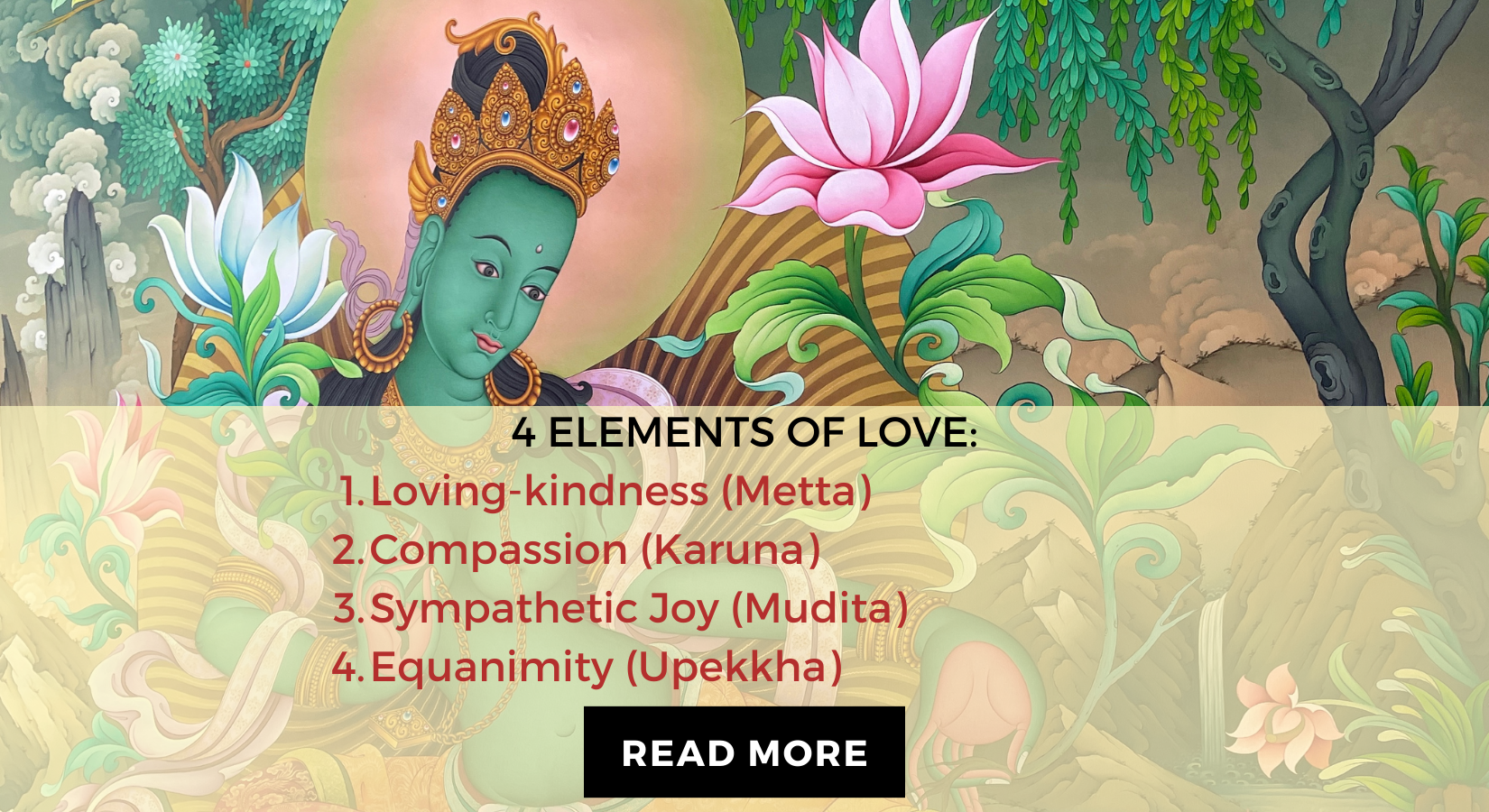Buddhism, an ancient spiritual tradition, is renowned for its profound teachings on love and compassion. These virtues lie at the heart of the Buddhist path, offering a transformative approach to how we relate to ourselves and the world. This article delves into the significance of love and compassion in Buddhism, and how practices like Thangka painting, particularly the depiction of Green Tara, Chenrezig or any bodhisattva serve as powerful tools in cultivating these qualities within.
The Four Immeasurables: Foundations of Love and Compassion

Central to Buddhist teachings are the Four Immeasurables, or Brahmavihāras, which encompass:
-
Metta (Loving-kindness):
Metta, often referred to as loving-kindness, lies at the very core of Buddhist teachings. It is a practice that encourages the cultivation of an attitude of profound love and benevolence towards all living beings, without discrimination or exception. Metta is a wellspring of unconditional affection that transcends personal inclinations and biases. It involves the heartfelt aspiration for the well-being, happiness, and ultimate freedom from suffering, not only for oneself but for all sentient beings in the universe. This practice fosters a deep sense of interconnectedness, recognizing that our own well-being is intimately tied to the well-being of others. Through Metta, we seek to create a world where compassion and love flourish, creating a harmonious tapestry of beings supporting one another on their respective journeys.
-
Karuna (Compassion):
Karuna, the embodiment of compassionate action, is a fundamental aspect of Buddhist practice. It is the empathetic response that arises upon witnessing the suffering and pain of others. Unlike mere sympathy, Karuna compels us to take tangible steps towards alleviating this suffering. It is an active force that motivates individuals to extend a helping hand, offer solace, and provide comfort. Karuna is not bound by proximity or familiarity; it transcends all barriers, recognizing the inherent worth and dignity of every being. In the spirit of Karuna, we become beacons of solace, radiating warmth and understanding to those in need. Through this practice, we participate in the universal endeavor to alleviate the collective suffering of humanity, leaving no one behind.
-
Mudita (Sympathetic Joy):
Mudita, often described as sympathetic joy, is a profound emotional state that arises from witnessing the happiness, success, and well-being of others. It is a celebration of the accomplishments and joys experienced by those around us. Mudita is characterized by an absence of envy or jealousy; instead, it fosters an authentic sense of rejoicing in the good fortune of others. This practice encourages us to transcend ego-centric tendencies, recognizing that the success and happiness of one contribute to the greater tapestry of human well-being. By cultivating Mudita, we become supportive companions on the journey of life, sharing in the joys and triumphs of our fellow beings, and reinforcing the interconnectedness that binds us all.
-
Upekkha (Equanimity):
Upekkha, often translated as equanimity, is a state of balanced and even-minded mental stability. It is a quality that remains unshaken, especially in the face of difficult or challenging situations. Upekkha is not indifference or apathy; rather, it is a poised and steady response that arises from a deep understanding of the impermanence of circumstances. It allows us to navigate the ebb and flow of life with grace and composure, without being swayed by extremes of emotion. This practice provides a firm foundation for facing the inevitable ups and downs of existence, enabling us to remain centered and clear-sighted even amidst the storms of life.
These four qualities form the cornerstone of compassionate living in Buddhism, offering a roadmap to genuine and enduring happiness.
Green Tara: Embodiment of Love and Compassion

Thangka paintings, intricate and spiritually charged artworks, serve as visual aids to deepening our understanding of Buddhist principles. Among the many revered figures depicted in Thangkas, Green Tara stands out as a quintessential representation of love and compassion.
With her radiant green complexion, Green Tara symbolizes the nurturing energy of nature, embodying the boundless love that encompasses all living beings. Her eyes, brimming with loving-kindness, and her hand extended in a gesture of granting boons, radiate a palpable sense of compassion and care.
Learning from Green Tara: A Visual Meditation
Engaging with Thangka paintings of Green Tara can serve as a form of visual meditation. By simply gazing upon her compassionate countenance, we are reminded of the limitless potential for love and kindness that resides within us. It serves as an invitation to nurture these qualities in our own hearts and extend them outwards to all beings.
Practicing Love and Compassion in Daily Life
While Thangka paintings offer a contemplative gateway, the real essence of love and compassion lies in their practical application in our daily lives. Acts of kindness, empathy, and understanding form the bedrock of compassionate living. This may involve being present for others, offering a listening ear, or providing support when needed. Moreover, it encompasses the practice of forgiveness and the release of resentment, fostering a climate of harmony and understanding.
The Bodhisattva Ideal: A Call to Compassionate Action

In Mahayana Buddhism, practitioners are inspired by the Bodhisattva ideal. A Bodhisattva is an individual who has attained a high level of spiritual realization but chooses to delay their own enlightenment until all sentient beings have also reached liberation. This selfless commitment to the welfare of others exemplifies the pinnacle of love and compassion.
By embracing the Bodhisattva ideal, we recognize that our spiritual journey is intricately linked with the well-being of all beings. It propels us to act not only for our own salvation but for the liberation and happiness of every being in the universe.
Overcoming Challenges in Cultivating Love and Compassion
In a world often characterized by division and strife, the cultivation of love and compassion can be challenging. Yet, it is precisely in the face of adversity that these qualities find their greatest potential for transformation. By actively working to nurture love and compassion, we transcend the limitations of reactivity and aversion. We learn to respond to life's challenges with wisdom, kindness, and equanimity.
Conclusion: Illuminating the Path to Enlightenment
In Buddhism, love and compassion are not just sentiments, but powerful forces that lead to enlightenment. As we deepen our understanding and practice of these qualities, we not only free ourselves from suffering but become beacons of light, radiating warmth and kindness to all beings. Thangka paintings, particularly those depicting Green Tara, serve as visual anchors for our contemplation, reminding us of the boundless potential for love and compassion that resides within us. Through dedicated practice and a genuine commitment to the welfare of all beings, we can walk the path of love and compassion, ultimately finding our way to profound wisdom, peace, and spiritual liberation.



